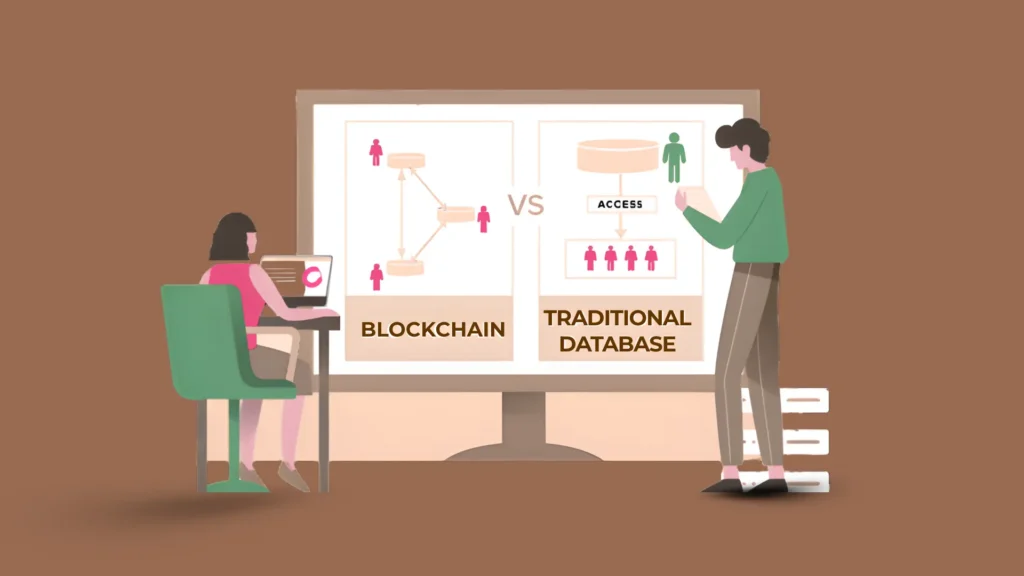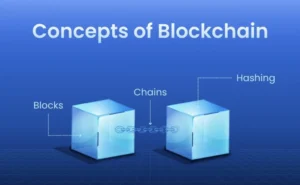
In the virtual world, data integrity, security, and accessibility are now more important than ever before. Companies depend on data to promote innovation, make decisions, and promote expansion. Databases provide the base for every modern business, from financial systems and enterprise applications to e-commerce and IoT devices. trust and transparency.
Blockchain technology has established itself as a transformational alternative to traditional databases with a completely different approach to data storage and integrity, centered on concepts of decentralization, transparency, and immutability.
Rather than operating based on a single authority like conventional centralized databases, blockchain is instead developed over a distributed peer-to-peer network where each participant in the peer-to-peer network has their own independent and verifiable copy of the ledger. This establishes trust and removes intermediaries while also adding security and integrity, as data cannot be manipulated once the transaction is complete.
At Nadcab Labs, our blockchain experts have been able to deploy decentralized ledger systems that completely eliminate single points of failure, all while securely managing and storing data in a manner that remains transparent and auditable. This becomes especially vital in industries like those in finance, healthcare, supply chain, and government, where trust is a critical component of the transaction itself.
Data Management in the Modern World
Rising Data Challenges
- The volume and complexity of data have increased at an unprecedented rate as a result of businesses digital transformation. Petabytes of data are now produced annually by organizations, and real-time processing and analytics are no longer optional. Despite their robustness, traditional databases struggle to meet these demands.
Important pressures consist of:
- Security and Compliance: Data breaches and regulatory requirements (e.g., GDPR, HIPAA, CCPA) make traditional systems vulnerable without advanced security measures. (isaca )
- Integration Complexity: Conventional databases may become overloaded as a result of organizations’ growing need to combine structured, semi-structured, and unstructured data from various sources.
- Global Scale: Since contemporary companies conduct business internationally, they need databases that can manage distributed, multi-regional access without experiencing a decline in performance.
- Trust and Transparency: Systems that are auditable and allow participants to independently confirm transactions are necessary in multi-party settings like financial networks and supply chains.
Limitations of Traditional Databases
For decades, traditional databases have been trusted, but they are now facing serious limitations in a hyper-connected world:
- Increased Centralized Risks: A single point of control has a higher risk of outages, breaches, and misuse.
- Limited Transparency: Audit trails typically require highly complex and time-consuming manual validation.
- Scalability Hurdles: Scaling up or out comes with excessive cost and technical skill.
- Operational Expenses: The increase in maintaining the infrastructure, licenses, and administrative staff adds repetitive costs.
All of this explains the rising interest among enterprises for decentralized solutions. At Nadcab Labs, we have seen organizations adopt blockchain not to totally displace databases, but to add resilience, traceability, and multi-party collaboration with existing systems.
Traditional Databases: Structure and Function
Definition
For business and analytical purposes, a traditional database is a centralized system that effectively stores, arranges, and retrieves data. In order to preserve dependability and data integrity, particularly for transactional workloads, these systems adhere to the ACID principles (Atomicity, Consistency, Isolation, Durability).
Types of Traditional Databases
- Relational databases, such as MySQL, Oracle, and Microsoft SQL Server, are used to store structured data in tables with predefined relationships.
- NoSQL databases, such as MongoDB and Cassandra, can handle unstructured or semi-structured data and provide flexible schemas.
- In-Memory Databases: Keep information in RAM so that low-latency apps and fast analytics are possible (e.g., Redis, SAP HANA).
- Graph databases, such as Neo4j and Amazon Neptune, are perfect for social networks, recommendation engines, and fraud detection because they highlight the connections between data points.
Although traditional databases are still essential for structured, fast operations, decentralized technologies are increasingly being used in conjunction with them to satisfy contemporary standards for transparency and trust.
Key Differences Between Blockchain and Traditional Databases
| Feature | Traditional Databases | Blockchain |
|---|---|---|
| Structure | Data in tables; editable or deletable. | Data in linked blocks; immutable. |
| Control | Central administrator. | Decentralized consensus. |
| Security | Access control and encryption. | Cryptography and consensus. |
| Transparency | Limited to authorized users. | Visible ledger for participants. |
| Scalability | Fast and structured workloads. | Slower but scalable with Layer-2. |
| Governance | Admin-controlled. | Rule- and contract-based. |
| Cost | High setup and admin costs. | Lower long-term cost. |
Expert Insight: According to a Deloitte 2024 Blockchain Survey, over 75% of enterprises plan to integrate blockchain alongside traditional databases for improved trust and transparency.
A. Data Structure and Storage
- Traditional Database: Arranges information using flexible document models or rows and columns. As needed, data can be added or removed.
- Blockchain: Creates an unchangeable chain by organizing data into blocks that are connected chronologically. Data cannot be changed or deleted once it has been recorded, resulting in permanent, auditable records.
B. Centralization vs Decentralization
- Traditional: centralized under a single database administrator or authority, resulting in a single point of failure.
- Blockchain: Distributed among several nodes, enhancing fault tolerance and resilience. Consensus guarantees that everyone involved is in agreement about the ledger’s current state.
C. Security
- Traditional: centralized under a single database administrator or authority, resulting in a single point of failure.
- Blockchain: dispersed among several nodes, enhancing fault tolerance and resilience. Consensus guarantees that everyone involved is in agreement about the ledger’s current state.
D. Transparency and Auditability
- Traditional: Passwords, encryption, and administrative supervision are essential components of security.
- Blockchain: uses consensus algorithms and cryptography to protect data, making tampering practically impossible.
E. Scalability and Performance
- Traditional: scalable both horizontally and vertically; optimized for high-speed transactional workloads.
- Blockchain: Consensus processes make it slower, but developments like off-chain solutions, sharding, and Layer 2 scaling are boosting efficiency.
F. Governance and Control
- Traditional: database administrators for centralized governance.
- Blockchain: reduced dependence on a single authority through distributed governance using consensus rules and smart contracts.
G. Cost Considerations
- Traditional: Infrastructure, licensing, and operational staff are among the expenses.
- Blockchain: Although there may be transaction fees, long-term expenses can be decreased by relying less on broker.
Where Blockchain Outperforms Traditional Databases

Blockchain is especially helpful in situations that call for trust, auditability, and multi-party cooperation.
A. Supply Chain Traceability
End-to-end visibility between manufacturers, distributors, retailers, and suppliers is guaranteed by blockchain. A tamper-proof supply chain record is produced by recording each transaction on the ledger.
Walmart, for instance, improves food safety and reduces fraud by using blockchain technology to track food products from the source to the store.
B. Financial Services
Blockchain speeds up decentralized finance (DeFi), cross-border payments, and settlements. Because consensus is used to verify transactions rather than broker, operations can be completed more quickly and affordably.
Example: While Ethereum-based DeFi platforms enable lending, borrowing, and smart contracts, Ripple enables real-time cross-border payments.
C. Healthcare Data Management
Interoperable and secure electronic health records (EHRs) are supported by blockchain. Healthcare providers can guarantee adherence to privacy laws such as HIPAA, while patients have control over who can access their data.
D. Government Records
Blockchain enhances transparency and reduces corruption by providing immutable digital records. Digital voting systems, identity verification, and land registries are a few examples of applications.
For instance, Estonia has effectively integrated blockchain technology to manage citizen identities, improving security and openness.
E. Digital Assets and Intellectual Property
Blockchain protects creative works, verifies ownership, and automates royalties through smart contracts and non-fungible tokens (NFTs).
Example: Digital art can be sold by artists with automated revenue sharing and permanent ownership proof.Limitations and Challenges of Blockchain
Blockchain is not a universal solution and faces several practical challenges:
- Scalability: Transaction throughput is slowed by consensus-based validation.
- Energy Consumption: PoS and other protocols reduce the high energy consumption of PoW-based blockchains.
- Privacy and Compliance: “Right to be forgotten” regulations such as the GDPR may clash with immutability.
- Integration with Legacy Systems: Implementing blockchain may necessitate major adjustments to the infrastructure.
- Storage Needs: Expanding ledgers necessitate a large amount of network and storage space.
These limitations show that rather than completely replacing traditional databases, blockchain is best utilized in conjunction with them.
Trust the Chain. Build with Nadcab!
Transform your business with secure and scalable blockchain solutions.
Industry-Specific Applications
Finance and Banking
Secure loan management, fraud detection, and immediate cross-border settlements are all made possible by blockchain. By automating intricate financial processes, smart contracts lower operational risk.
Healthcare
Blockchain’s immutability and privacy-preserving qualities are advantageous for clinical trial data management, drug supply tracking, and secure patient records.
Supply Chain and Logistics
Blockchain reduces delays, inefficiencies, and counterfeiting by providing traceable and verifiable data from raw materials to end users.
Government and Public Services
Simplifying and increasing transparency in land registries, identity verification, and tax collection can lower corruption and boost public confidence.
Entertainment and Digital Media
Blockchain’s automation and transparency are advantageous for NFTs, digital rights management, and royalty distribution.
The Future: Coexistence and Integration
Blockchain and Databases Together
The most effective data management strategies often involve both blockchain and traditional databases:
- Databases handle high-speed, structured operations.
- Blockchain provides verifiable, tamper-proof records for multi-party processes.
Hybrid Models and Enterprise Adoption
- Businesses are investigating hybrid strategies that combine the transparency and trust of blockchain technology with the effectiveness of conventional databases:
- private blockchains integrated with CRM and ERP systems.
- Large datasets can be stored off-chain, while proofs are kept on-chain.
- Prior to enterprise-wide implementation, pilot projects are being implemented in the fields of finance, healthcare, and logistics.
Emerging Innovations
- Layer 2 Solutions: Lower expenses and speed up transactions.
- Sharding: To improve scalability, blockchains are divided into smaller sections.
- Communication between networks is made possible by blockchain interoperability, which produces multi-chain ecosystems.
Strategic Implementation Considerations
Businesses should evaluate:
- Data Sensitivity: Is immutability required?
- Collaboration Needs: Are multiple independent parties sharing data?
- Performance Requirements: Are high-speed transactions critical?
- Cost-Benefit Analysis: Will blockchain reduce intermediaries and operational risk?
Trends in Blockchain and Database Integration

The integration of blockchain technology with traditional databases is redefining the future of data management systems. Trends to keep an eye on include:
- AI-Driven Insights: Reliable, real-time insights are made possible by fusing AI analytics with blockchain’s immutable data.
- Integration of Edge Computing: Decentralized systems that process data at the edge lower network load and improve latency.
- Cross-Industry Collaborations: Blockchain-based solutions for shared data transparency are being adopted by financial consortiums, healthcare networks, and supply chains more and more.
- Green Blockchain Initiatives: Blockchain becomes more sustainable with energy-efficient consensus protocols.
These advancements point to a future in which performance, transparency, and decentralization coexist, enabling businesses to make safer, quicker, and more informed decisions.
Conclusion
At present, groups across the world are in the process of utilizing blockchain technologies and the conventional database infrastructure to manage and secure data. In an age of data, blockchain technology is a decentralized, transparent, and immutable technology, which is why it is a widely accepted technology in the areas of trust, accountability, and security of data. Nevertheless, the conventional database continues to provide its own strengths of speed, structure, and cost as another modality of data management to support a business.
It is clear that the direction of data management belongs in both systems working together wherever possible to maintain the benefits from blockchain technology trust, and transparency with the performance and reliability of traditional databases into a digital connected ecosystem that is smarter and secure.
If you are looking for a blockchain-related development project, you can visit Nadcab Labs or contact us directly to get expert guidance on building reliable blockchain solutions for your business.
Frequently Asked Questions
What is the main difference between blockchain and a traditional database?
The primary difference lies in structure and control. A traditional database is centralized and managed by a single authority, while a blockchain is decentralized, where data is stored across multiple nodes and verified through consensus mechanisms.
Can blockchain completely replace traditional databases?
Not entirely. Blockchain is ideal for applications requiring transparency, security, and immutability, while traditional databases are better suited for fast, high-volume transactional tasks. In most cases, businesses adopt a hybrid model combining both.
Why is blockchain considered more secure than traditional databases?
Blockchain uses cryptography, distributed consensus, and immutability to ensure data integrity. Once data is added to the blockchain, it cannot be altered or deleted, reducing the risk of fraud and unauthorized tampering.
Which industries benefit most from using blockchain over traditional databases?
Industries like finance, healthcare, supply chain, logistics, and government sectors benefit the most. These fields require transparent records, trust between multiple parties, and tamper-proof data management.
What are the limitations of blockchain compared to traditional databases?
Blockchain faces challenges like slower transaction speed, higher energy consumption (depending on consensus type), and integration complexity with legacy systems. Traditional databases, however, handle structured data more efficiently.
How can blockchain and traditional databases work together?
Businesses can integrate blockchain for verification, auditability, and transparency while continuing to use databases for real-time transactions and analytics. This hybrid approach offers both reliability and trust.







